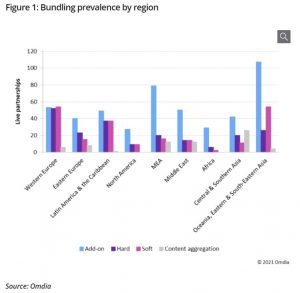
After more than 35 years of operation, TBI is closing its doors and our website will no longer be updated daily. Thank you for all of your support.
TBI Tech & Analysis: Why Lat Am pay-TV is susceptible to lost live sports exclusivity
 With SVOD services in the region now transmitting live sports, Lat Am pay-TV providers face a new threat, explains Omdia research analyst Juan D. Villegas.
With SVOD services in the region now transmitting live sports, Lat Am pay-TV providers face a new threat, explains Omdia research analyst Juan D. Villegas.
With football as its main attraction, live sports broadcasting in Latin America is one of the most important content types for pay-TV. While providers carry key championships such as Liga MX, Brasileirao, and the Superliga Argentina, sports are relatively secure within the pay-TV ecosystem. Pay-TV providers have a higher ARPU in comparison with OTT services so they can afford high-cost transmission rights. Lately, however, streaming platforms are starting to invest in sports content and compete with pay-TV for sports rights.
Live sports streaming still in its infancy
Some SVOD services have integrated sports as an add-on in the past, such as Prime Video channels. However, a significant change has been their integration at no additional cost to the subscriber. One example has been Disney’s Star+ in Latin America, launched in August 2021, where ESPN programming, among other professional sports leagues and non-sport content such as The Simpsons and BIOS docuseries, is available for an average of $8.80 per month. At the time of writing, the service has seen a slow take-off, but it is expected to reach around 2.7 million subscriptions by 2025, plus 3.2 million for Combo+ (a Disney+ and Star+ bundle) versus 12.3 million for its sibling service Disney+, launched in November 2020.
With services such as Star+ and other existing players such as DAZN offering live sports directly to consumers, the pressure on pay-TV’s dominant position is forming. One strategy to mitigate these risks is to form partnerships with OTT video players.
Partnerships can battle the loss of sports exclusivity
Pay-TV operators have already formed different kinds of partnerships with OTT providers such as Netflix, Prime Video, HBO Max, Disney+, and, more recently in Latin America, Star+. These partnerships range from add-ons of OTT services in the pay-TV provider’s user interface (STB or streaming box/stick) to less-popular super-bundles within which multiple OTT services are included in the pay-TV plan at a discounted price. Globally, around 40% of partnerships are formed by add-on plans with super-bundles growing more slowly.
Thus, a partnership can be a win-win proposition with pay-TV providers still holding a reasonable portion of rights. By bundling OTT video services that contain sports content, it further contributes to retaining existing subscribers and simultaneously increase reach for OTT players. However, a negative outcome for pay-TV providers is also an increasing possibility as users potentially decide to only stick with a specific OTT service if it fulfils their needs.
What Disney has done with Star+ is certainly a cornerstone for what the future of OTTs can be like. However, the main issue in Latin America remains whether enough members of the public can afford multiple services at a time when budget constraints are an issue across the region.
This article was taken from the Omdia Analyst Opinion piece named ‘Latin America: Traditional pay TV threatened by loss of live-sports exclusivity to streamers’, available here.



